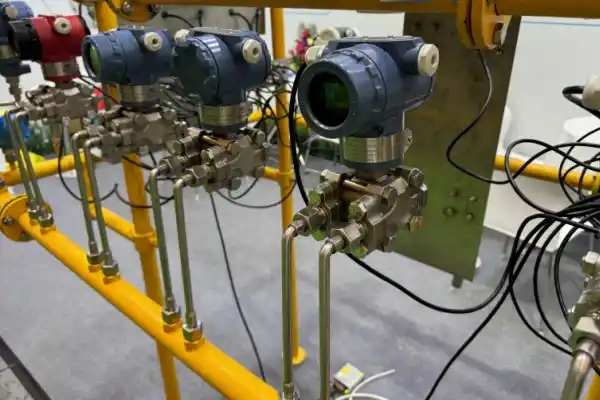Table of Contents
ToggleYou may observed that Impulse Line Installation is always done in a slopping manner.
Impulse lines role in industrial process measurement is very critical. Whether you are measuring pressure in gas, liquid, or steam applications, the accuracy of your instrument depends greatly on how the impulse line is installed.
One of the most common and important practices is Impulse Line Installation in a sloping manner.
At first glance, this may look like a small detail, but in reality, it is closely tied to proper signal transmission, long term reliability and the overall health of the measurement system.
In this article, we will explore why impulse lines are usually installed at an angle, what problems the slope helps prevent, and how this practice ensures accurate pressure readings in demanding industrial environments.

What Are Impulse Lines?
Impulse lines are small diameter tubes that carry the pressure of the process fluid from the pipeline or vessel to measuring instruments such as pressure gauges, transmitters, differential pressure sensors, and flow elements.
They act like a pathway that transfers the pressure information without exposing the instrument directly to harsh process conditions.
Because these lines carry real-time pressure signals, even small disturbances such as trapped liquid, gas bubbles, or blockages can distort the measurement.
This is why the method of Impulse Line Installation is so important.
Why Are Impulse Lines Installed in a Sloping Manner?
A slope is not added for aesthetic reasons there is solid engineering logic behind it. A properly sloped impulse line helps maintain accurate, stable, and reliable pressure transmission under varying process and environmental conditions.
Below are the major reasons behind sloping impulse lines.
1. Helps in Liquid Drainage (For Gas and Steam Services)
In gas or steam applications, condensation is common. Steam cools and forms water; gases may condense into small droplets. If this water accumulates inside the impulse line, it acts like a barrier and interferes with the pressure signal.
A downward slope toward the process line allows the condensed liquid to drain naturally due to gravity.
This helps ensure:
- No pooling of liquid
- Stable and accurate pressure transmission
- Reduced need for manual draining
Without this slope, the measurement may fluctuate or respond sluggishly.
2. Allows Trapped Gas to Vent Out (For Liquid Services)
In liquid applications such as water, fuel, or chemicals, the opposite problem occurs: gas or air bubbles may get trapped in the impulse line.
These bubbles compress under pressure, which leads to:
- Slow instrument response
- Incorrect readings
- Droop or pulsation
To avoid this, the Impulse Line Installation is sloped toward the instrument. This lets air bubbles travel upward to the transmitter, where they can be vented safely.
3. Prevents Blockages and Clogging
Many process fluids contain:
- Rust
- Scale
- Particles
- Sludge
- Products that can solidify
If the impulse line is horizontal or poorly sloped, these materials may settle and harden, causing a blockage. A sloping installation keeps the fluid moving and prevents debris from settling inside.
A clogged impulse line can cause:
- Zero pressure transfer
- Over-range conditions
- Damage to differential pressure transmitters
- Dangerous measurement failure
A slope helps maintain the internal cleanliness of the line and ensures long-term reliability.
4. Reduces the Risk of Water Hammer
A sudden rush of liquid inside the impulse line can create rapid pressure surges known as water hammer.
These pressure spikes can damage sensitive instruments and lead to premature failure.
A sloped impulse line helps:
- Control liquid movement
- Prevent sudden slugs of water
- Reduce the impact of fast fluid transitions
This is especially important in steam applications where condensate movement can be violent.
5. Handles Temperature Effects Smoothly
Temperature variations can cause phase changes. For example:
- Steam turns into water
- Hydrocarbons may wax or solidify
- Hot liquids cool as they travel through the small impulse line
A sloping line ensures these phase changes do not trap fluids in unwanted locations. The slope allows fluids to circulate or drain, making the measurement more stable.
6. Improves Measurement Accuracy
Ultimately, the purpose of a pressure measurement system is accuracy. A poorly installed impulse line introduces noise, delay, or false readings.
A sloped line ensures:
- The line remains free of unwanted fluids
- The pressure signal is transmitted directly
- The transmitter receives a clean, stable signal
This improves:
- Repeatability
- Stability
- Response time
- Overall accuracy of the instrument
7. Makes Maintenance Easier
During regular plant operations, impulse lines may need:
- Flushing
- Purging
- Venting
- Draining
- Cleaning
A sloped line makes these tasks much easier. Technicians can quickly clear the line without dismantling it. This means:
- Less downtime
- Faster troubleshooting
- Lower maintenance cost
Important Considerations for Impulse Line Installation
Correct slope direction depends on the application:
For Gas or Steam Services
Slope towards the process line so that condensate drains out.
For Liquid Services
Slope towards the instrument so trapped gases can vent upward.
Slope Angle Selection
A typical installation uses:
- 1:10 to 1:12 slope
- Or about 5° to 10° angle
However, this depends on:
- Fluid properties
- Risk of condensation
- Solidification tendencies
- Process temperature and pressure
- Length of the impulse line
Maintain the Same Slope Throughout
The line must not have:
- Sags
- Low points
- Up-and-down bends
- Traps that hold fluid
A continuous slope ensures smooth flow and signal integrity.
What we learn today?
The sloping method of Impulse Line Installation is not just a standard practice but it is a key engineering requirement that ensures reliable and accurate pressure measurement in industrial applications.
A properly designed Impulse Line Installation helps prevent issues such as condensation buildup, trapped air, and blockages.
The slope helps deal with real-world challenges such as condensation, trapped gas, temperature fluctuations, blockages, and water hammer.
When installing steam, gas, or liquid systems, a carefully designed slope ensures that the impulse line remains clear, responsive, and easy to maintain.
Engineers follow strict Impulse Line Installation guidelines to maintain signal integrity and avoid measurement errors


I hope you like above blog. There is no cost associated in sharing the article in your social media. Thanks for Reading !! Happy Learning







